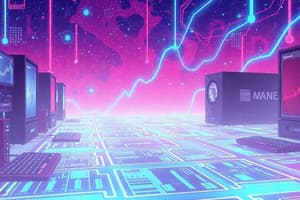Podcast
Questions and Answers
What is the primary function of Input/Output management in a computer system?
What is the primary function of Input/Output management in a computer system?
- To manage storage devices
- To manage user interfaces
- To manage data processing
- To manage data transfer between devices and CPU (correct)
What is the primary characteristic of a Hard Disk Drive (HDD) as a storage device?
What is the primary characteristic of a Hard Disk Drive (HDD) as a storage device?
- Low data transfer rate
- High access time
- High capacity (correct)
- Low capacity
Which of the following is NOT a function of an Operating System?
Which of the following is NOT a function of an Operating System?
- Process management
- Hardware manufacturing (correct)
- File management
- Memory management
What is the role of the Arithmetic Logic Unit (ALU) in CPU architecture?
What is the role of the Arithmetic Logic Unit (ALU) in CPU architecture?
What is the primary goal of algorithm design?
What is the primary goal of algorithm design?
Which algorithm design technique involves breaking down problems into smaller sub-problems?
Which algorithm design technique involves breaking down problems into smaller sub-problems?
What is the primary characteristic of a RISC (Reduced Instruction Set Computing) CPU?
What is the primary characteristic of a RISC (Reduced Instruction Set Computing) CPU?
What is the primary function of the Control Unit in CPU architecture?
What is the primary function of the Control Unit in CPU architecture?
Flashcards are hidden until you start studying
Study Notes
Input Output Management
- Input/Output (I/O) devices allow users to interact with the computer
- Types of I/O devices:
- Input devices: keyboard, mouse, scanner, microphone
- Output devices: monitor, printer, speaker, plotter
- I/O management involves:
- Managing data transfer between devices and CPU
- Handling I/O requests and interrupts
- Managing I/O operations concurrently
Storage Devices
- Types of storage devices:
- Primary storage (main memory):
- RAM (Random Access Memory)
- Cache memory
- Secondary storage:
- Hard Disk Drive (HDD)
- Solid State Drive (SSD)
- Optical storage (CD, DVD, Blu-ray)
- Flash storage (USB drives, memory cards)
- Primary storage (main memory):
- Storage devices characteristics:
- Capacity: amount of data that can be stored
- Access time: time taken to access data
- Data transfer rate: speed of data transfer
Operating Systems
- An Operating System (OS) manages computer hardware and software resources
- OS functions:
- Process management: creating, running, and terminating processes
- Memory management: allocating and deallocating memory
- File management: creating, deleting, and managing files
- I/O management: managing input/output operations
- Security: controlling access to computer resources
- Types of OS:
- Single-user, single-tasking OS
- Multi-user, single-tasking OS
- Multi-user, multi-tasking OS
- Real-time OS
CPU Architecture
- CPU (Central Processing Unit) architecture:
- Fetch-decode-execute cycle: retrieves, decodes, and executes instructions
- Components:
- Control Unit: manages instruction flow
- Arithmetic Logic Unit (ALU): performs arithmetic and logical operations
- Registers: small amount of on-chip memory
- Instruction Set Architecture (ISA): defines instructions and their formats
- CPU types:
- CISC (Complex Instruction Set Computing): executes complex instructions
- RISC (Reduced Instruction Set Computing): executes simple instructions
Algorithm Design
- Algorithm: a step-by-step procedure to solve a problem
- Algorithm design principles:
- Correctness: produces correct results
- Efficiency: minimizes time and space complexity
- Scalability: adapts to large input sizes
- Simplicity: easy to understand and implement
- Algorithm design techniques:
- Divide and Conquer: breaks down problems into smaller sub-problems
- Dynamic Programming: stores solutions to sub-problems
- Greedy Algorithm: makes optimal choices at each step
- Backtracking: tries different solutions until one works
Input Output Management
- Input devices allow users to interact with the computer, including keyboard, mouse, scanner, and microphone
- Output devices display or produce the results of computer processing, including monitor, printer, speaker, and plotter
- I/O management involves managing data transfer between devices and CPU, handling I/O requests and interrupts, and managing I/O operations concurrently
Storage Devices
- Primary storage (main memory) includes RAM (Random Access Memory) and cache memory, which temporarily hold data and program instructions
- Secondary storage devices, such as Hard Disk Drive (HDD), Solid State Drive (SSD), Optical storage (CD, DVD, Blu-ray), and Flash storage (USB drives, memory cards), hold data when the computer is powered off
- Storage devices are characterized by capacity, access time, and data transfer rate
Operating Systems
- An Operating System (OS) manages computer hardware and software resources, including process management, memory management, file management, I/O management, and security
- Types of OS include single-user, single-tasking OS, multi-user, single-tasking OS, multi-user, multi-tasking OS, and real-time OS
CPU Architecture
- CPU (Central Processing Unit) architecture involves the fetch-decode-execute cycle, which retrieves, decodes, and executes instructions
- CPU components include the Control Unit, Arithmetic Logic Unit (ALU), and Registers
- The Instruction Set Architecture (ISA) defines instructions and their formats, and CPU types include CISC (Complex Instruction Set Computing) and RISC (Reduced Instruction Set Computing)
Algorithm Design
- An algorithm is a step-by-step procedure to solve a problem, and should be correct, efficient, scalable, and simple
- Algorithm design techniques include Divide and Conquer, Dynamic Programming, Greedy Algorithm, and Backtracking
- These techniques are used to develop algorithms that produce correct results, minimize time and space complexity, adapt to large input sizes, and are easy to understand and implement
Studying That Suits You
Use AI to generate personalized quizzes and flashcards to suit your learning preferences.




